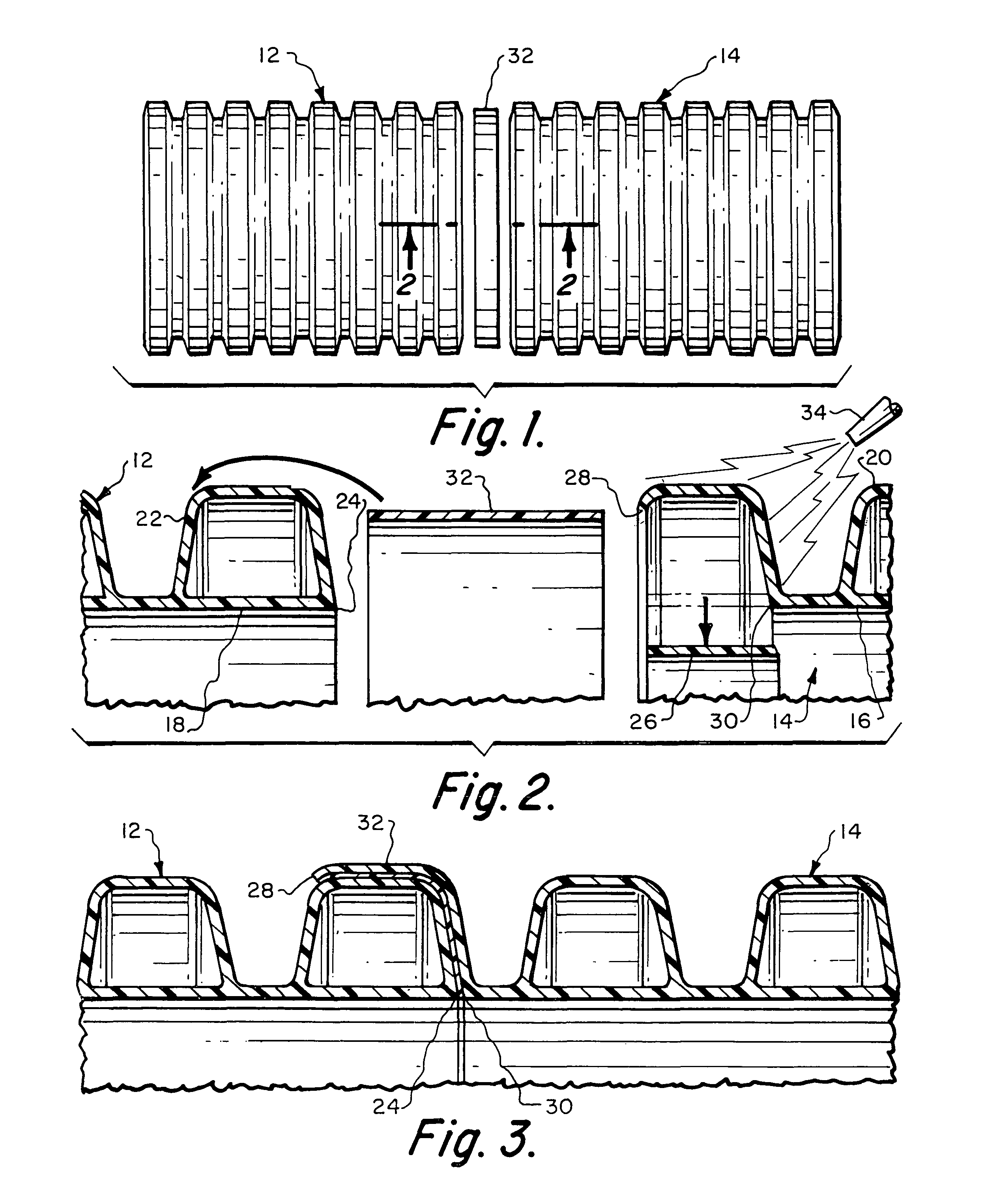[0012]It is, therefore, an object of the invention to provide apparatus and methods for joining pipes to each other, using the “shape memory” or “material memory” property of the pipe. Persons of ordinary skill in the art will understand that the invention can be practiced with a wide variety of pipe materials having a wide range of cross-sectional shapes, in which one or the other or both of a female end and a male end of pipes can be temporarily deformed to permit insertion of the male end into the female end. This provides a joint that is simple to manufacture and install, and can be more secure than prior art joints.
[0013]Persons of ordinary skill in the art will also understand that, although much of the description herein focuses on temporary deformation of a female end, alternative embodiments can include temporary deformation (compression) of the male end, or temporary deformation of both the male and female ends. Moreover, although certain embodiments discussed herein involve some delay between the initial deformation of the pipe end and the assembly of the male and female ends with each other, other embodiments may involve simply forcing the male and female ends into engagement without “prior” deformation of either end. In such applications, the “temporary deformation” discussed herein preferably occurs during the relatively brief process of assembling the pipe segments to each other.
[0014]Another object of my invention is the provision of apparatus and methods of the aforementioned character, in which a plurality of pieces of pipe includes a first piece of pipe fabricated with a cross-sectional sidewall pattern along its length that is similar in size and shape to the cross-sectional sidewall pattern of a second piece of pipe, the first piece having a first end that is temporarily deformed to function as a female end for receiving a non-deformed end of the second piece of pipe, the temporary deformation being both sufficiently large to permit the insertion of the non-deformed end of the second piece of pipe but also sufficiently small to ensure that the material memory of the first end returns the first end toward its original non-deformed configuration with sufficient compressive force to grip the second end and prevent its inadvertent removal from engagement with the first end. Engagement elements can be formed within the pipes' cross-sectional sidewall pattern to act between the first and the second pieces of pipe to increase the force necessary to disengage the pipe pieces from each other following assembly. Among the many alternative embodiments of the invention, the pipe sidewall pattern can include a corrugated exterior surface (with or without an internal non-corrugated liner element), can be non-corrugated with a generally constant radius along its length (a “mono-walled” pipe), or can be of other patterns.
[0015]A further object of my invention is the provision of apparatus and methods of the aforementioned character, in which the first piece of pipe includes a second end remote from the first end, the second end also being temporarily deformed to function as a female end for receiving a corresponding non-deformed end of a third piece of pipe, the third piece of pipe having a cross-sectional sidewall pattern along its length that is similar in size and shape to the cross-sectional sidewall pattern of the first and second pieces of pipe. One or more sealing elements can be positioned between confronting surfaces of the first and second pieces of pipe to help provide a watertight seal therebetween. Adhesive can be placed between confronting surfaces of the first and second pieces of pipe to bond the first and second pieces to each other upon insertion of the second piece into the female end of the first piece.
[0016]Yet another object of my invention is the provision of apparatus and methods of the aforementioned character, including providing a stretching tool for use in connection with the apparatus and methods. Among the many alternative embodiments, the tool can be a heating element to soften the end to be deformed, or can deform the end mechanically. In the latter approach, a channel can be provided in the tool, into which an edge of the first piece of pipe can be inserted in its originally fabricated shape, with the tool including means to temporarily stretch or deform the edge to the female end configuration capable of receiving the non-deformed end of the second pipe piece. The mechanical tool embodiments can include a plurality of rollers positionable along the inside and outside surfaces of the eventual female end of the first piece of pipe, and can further include means for exerting force to act between the rollers and the eventual female end to deform the female end from its originally fabricated shape.
[0017]A still further object of my invention is the provision of apparatus and methods of the aforementioned character, including a temporary stretch-holding device for use in connection with the apparatus and methods. Among the many alternative embodiments, the device can include a first portion for temporary insertion into the deformed female end of the first pipe piece. Preferably, the first portion is sized and configured to retain a sufficient degree of the deformation of the female end so that, upon the removal of the device from the female end, the non-deformed end of the second piece of pipe may be inserted into engagement with the female end. The device can also include a second portion to assist in desired removal of the device from its temporary insertion into the deformed female end.
 Login to View More
Login to View More 


